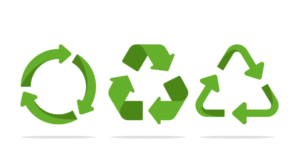In the sunny state of California, managing your household waste is not only a civic duty but also an environmental responsibility. Understanding what can go into your green waste bin is essential. While you might ponder questions like, “how many bags of garbage can I put out for waste management?” The real issue lies in knowing the correct content for those bags.
The Green Bin Basics
California’s green waste bins serve a crucial role in waste management, primarily for the disposal of organic materials that can naturally decompose. These bins are a vital component of environmental sustainability efforts, but it’s essential to understand what can and cannot be placed inside them to ensure their effectiveness. Let’s break down the materials that can and cannot go into the green bin, providing you with a clear understanding of how to properly dispose of organic waste in California.
Materials You Can Put in the Green Bin
When using your green bin for organic waste disposal, you can confidently include the following materials:
| Organic Material | Description |
|---|---|
| Grass Clippings | Cut grass from your lawn or yard. |
| Leaves and Weeds | Fallen leaves and garden weeds. |
| Garden Prunings and Shrubs | Trimmed branches, pruned shrubs, and small garden debris. |
| Tree Limbs (≤ 6 inches) | Branches and limbs with a diameter of 6 inches or less. |
| Flowers and Floral Trimmings | Discarded flowers and trimmings from your garden. |
| Vegetable Food Scraps | Leftover fruits and vegetables, including peels and cores. |
| Coffee Grounds and Filters | Used coffee grounds and paper filters. |
| Teabags | Used teabags from brewing tea. |
These materials are organic, biodegradable, and suitable for decomposition in green waste facilities. Properly disposing of them in your green bin contributes to reduced landfill waste and supports composting efforts.
Materials You Shouldn’t Put in the Green Bin
To ensure the efficiency of green waste recycling and prevent contamination, avoid placing the following materials in your green bin:
| Non-Organic Material | Description |
|---|---|
| Plastic Bags | Any type of plastic bag, even if they contain organic waste. |
| Treated Wood or Lumber | Wood that has been treated with chemicals or painted. |
| Animal Waste or Pet Litter | Feces and litter from pets such as cats and dogs. |
| Meat or Dairy Products | Leftover meat, bones, dairy products, or expired food. |
| Food-Soiled Paper Products | Paper products contaminated with food, like pizza boxes. |
| Grease or Oils | Cooking oils, grease, and fats. |
By excluding these non-organic materials from your green bin, you help maintain the purity of the organic waste stream, making it easier for recycling facilities to convert it into valuable compost and mulch. Contaminants like plastic bags and treated wood can hinder the decomposition process and reduce the overall environmental benefits of organic waste recycling.
Why Proper Green Bin Usage Matters
Properly using your green bin is crucial for several reasons:
- Environmental Benefits: Recycling organic waste through green bins reduces landfill waste, methane emissions, and greenhouse gasses, contributing to a cleaner and healthier environment;
- Resource Conservation: Organic materials in green bins are transformed into compost and mulch, enriching soil quality and reducing the need for chemical fertilizers in gardening and agriculture;
- Cost Savings: Effective green bin use reduces waste disposal costs for municipalities and lowers the burden on landfill facilities;
- Community Health: Minimizing contamination in green bins ensures that composted materials are safe for use in local gardens and landscaping, promoting community well-being.
Tips for Effective Green Waste Management

One common question that arises is, “how many bags of garbage can I put out for waste management?” The answer to this question can vary depending on your locality. To ensure you are handling your green waste responsibly, follow these tips for effective green waste management.
Bagging it Right
One of the key considerations when managing your green waste is how you bag it. Using the right type of bags is crucial for environmentally friendly disposal. Here are some important points to keep in mind:
- Check Local Bag Limits: As mentioned earlier, bag limits for green waste can vary by locality in California. It’s vital to check with your local waste management agency to determine the specific bag limits applicable in your area. This information will help you avoid any fines or penalties for exceeding the allowed limit;
- Use Compostable Bags: Regardless of your location, it’s a good practice to use compostable bags for your green waste. Compostable bags are designed to break down naturally and contribute to organic matter in composting facilities. They are an eco-friendly choice that aligns with sustainable waste management practices.
Yard Waste Hygiene
Maintaining the hygiene of your green waste is essential not only for the environment but also for the smooth operation of waste management processes. Here’s what you need to know:
- Avoid Contaminants: Ensure that your green waste is free from contaminants such as plastic, metal, or non-organic materials. These contaminants can disrupt the composting process and create problems for waste management facilities. Sorting your waste properly before disposal is crucial.
Storing Green Waste
Sometimes, you may find yourself with more green waste than your regular bin can accommodate. In such cases, it’s important to manage the excess waste responsibly. Follow these steps:
- Ask About Bag Limits: If you have a large amount of green waste to dispose of and are unsure about the bag limits, contact your local waste management agency for guidance. They can provide specific information on how many bags you can put out for collection;
- Store Excess Waste: If you have exceeded the bag limit or need to dispose of additional green waste, store it in a cool, dry place. This prevents odors and pests and ensures that the waste remains in good condition until the next collection day;
- Schedule Multiple Collections: If your locality permits multiple collections, take advantage of this option. It allows you to spread out your green waste disposal over several collection days, avoiding the need to put out an excessive number of bags at once.
Reducing Organic Waste
One effective way to minimize the need to question “how many bags of garbage can I put out for waste management?” is by actively reducing your organic waste. Composting at home is an excellent strategy for achieving this goal:
- Home Composting: Consider setting up a home composting system. Composting not only reduces the amount of green waste you generate but also provides you with nutrient-rich compost that can be used to enrich your garden soil. It’s a sustainable and environmentally friendly practice that aligns with the principles of waste reduction and resource conservation.
The Impact of Proper Green Waste Management

Every individual’s commitment to correctly sorting waste has a profound impact on the environment. Proper green waste management is crucial for several reasons:
Landfill Reduction
Organic waste constitutes a significant portion of the waste stream. When individuals divert this organic waste from landfills, it contributes significantly to reducing the harmful greenhouse gases, particularly methane, that landfills emit during decomposition. By properly managing green waste, we can help mitigate the adverse effects of these emissions on climate change and overall air quality.
Recycling into Compost
One of the key benefits of proper green waste management is the transformation of organic waste into compost. Compost serves as a valuable resource as it acts as a nutrient-rich soil conditioner. When incorporated into soil, compost enhances its fertility, water retention, and microbial activity. This reduces the need for chemical fertilizers, which can be harmful to the environment, and fosters healthier plant growth. Therefore, promoting composting through effective green waste management not only reduces waste but also enhances soil quality and supports sustainable agriculture.
Water Quality Protection
Improper disposal of waste, especially garden chemicals and treated wood, can have detrimental effects on water quality. When these pollutants enter water bodies, they can lead to contamination and harm aquatic ecosystems. Proper green waste management is essential to ensure that these pollutants are kept out of the water cycle. By preventing the release of harmful substances into our waterways, we safeguard both aquatic life and the quality of water available for human consumption.
Conservation of Resources
Efficiently managing green waste through composting and recycling has broader implications for resource conservation. It reduces the need for new landfill sites, which can be environmentally disruptive and costly to establish. Moreover, it minimizes the energy-intensive processes involved in landfill management, such as transportation, compaction, and long-term monitoring. Therefore, embracing proper green waste management practices not only benefits the environment but also conserves valuable resources and reduces the environmental footprint associated with waste disposal.
Community Initiatives and Your Role
While individual efforts play a significant role in waste management, community-driven approaches can amplify the benefits and create a more sustainable environment. Here’s how communities and you can further improve green waste management:
Community Composting Programs
Many neighborhoods have initiated communal composting systems where residents can contribute their organic waste. This approach not only reduces the volume of green waste in landfills but also produces nutrient-rich compost for gardening. Your role is crucial in such programs:
- Participate Actively: Make use of community compost bins and contribute your organic waste regularly;
- Encourage Neighbors: Educate and encourage your neighbors to participate in community composting to maximize its impact.
Education and Workshops
Understanding the nuances of effective green waste management is essential. Community workshops and educational programs can provide valuable insights. Your role in this context includes:
- Attend Workshops: Participate in community workshops that cover topics like waste reduction, recycling, and composting;
- Organize Workshops: If you have expertise in waste management, consider organizing workshops to educate fellow residents;
- Promote Awareness: Share knowledge gained from workshops with your community to foster collective action.
Tree Planting Drives
Trees play a pivotal role in managing green waste by absorbing carbon dioxide and producing oxygen. Organizing or participating in tree-planting drives can be an effective community initiative:
- Organize Drives: Take the lead in planning tree-planting events in your neighborhood;
- Participate Actively: Join local tree planting campaigns to contribute directly to the environment;
- Advocate for Green Spaces: Encourage the establishment and maintenance of green spaces in your community.
Garden Sharing
Garden sharing is a fantastic way to reduce green waste generation and build a sense of community. Your role in garden sharing includes:
- Share Your Garden: If you have a garden, consider sharing space with neighbors interested in gardening;
- Collectively Manage Waste: Collaborate with fellow gardeners to compost green waste from your shared gardens.
Conclusion
California is known for its pristine beaches, lush forests, and commitment to a greener planet. As residents, understanding the proper disposal of organic waste is our responsibility. Remember, while it’s essential to know “how many bags of garbage can I put out for waste management,” it’s even more vital to ensure those bags contain the right kind of waste. Let’s keep California green, one bin at a time!
FAQs
Composting converts organic waste into stable carbon compounds, reducing the release of methane (a potent greenhouse gas) that would have occurred if the waste decomposed in a landfill without oxygen.
Both have their advantages. While municipal programs handle larger volumes and have streamlined processes, community composting programs often engage residents more directly, fostering environmental awareness and responsibility.
Vermicomposting is a method of composting using worms, typically red wigglers, to break down organic waste. It’s an efficient way to compost kitchen scraps and is suitable for small spaces like apartments.
Special community events may have different regulations. Always check with the event organizers or local waste management agency for guidelines during these events.
Generally, no. Garden waste, whether from private or shared gardens, should be managed as per local green waste guidelines. If you’re ever unsure, remember to ask, “how many bags of garbage can I put out for waste management?” and refer to local regulations.
Start by gauging interest among neighbors. Utilize community boards, social media groups, or local meetings to discuss the idea. Secure a suitable space, establish guidelines, and promote responsible waste management practices, including understanding “how many bags of garbage can I put out for waste management.”









+ There are no comments
Add yours